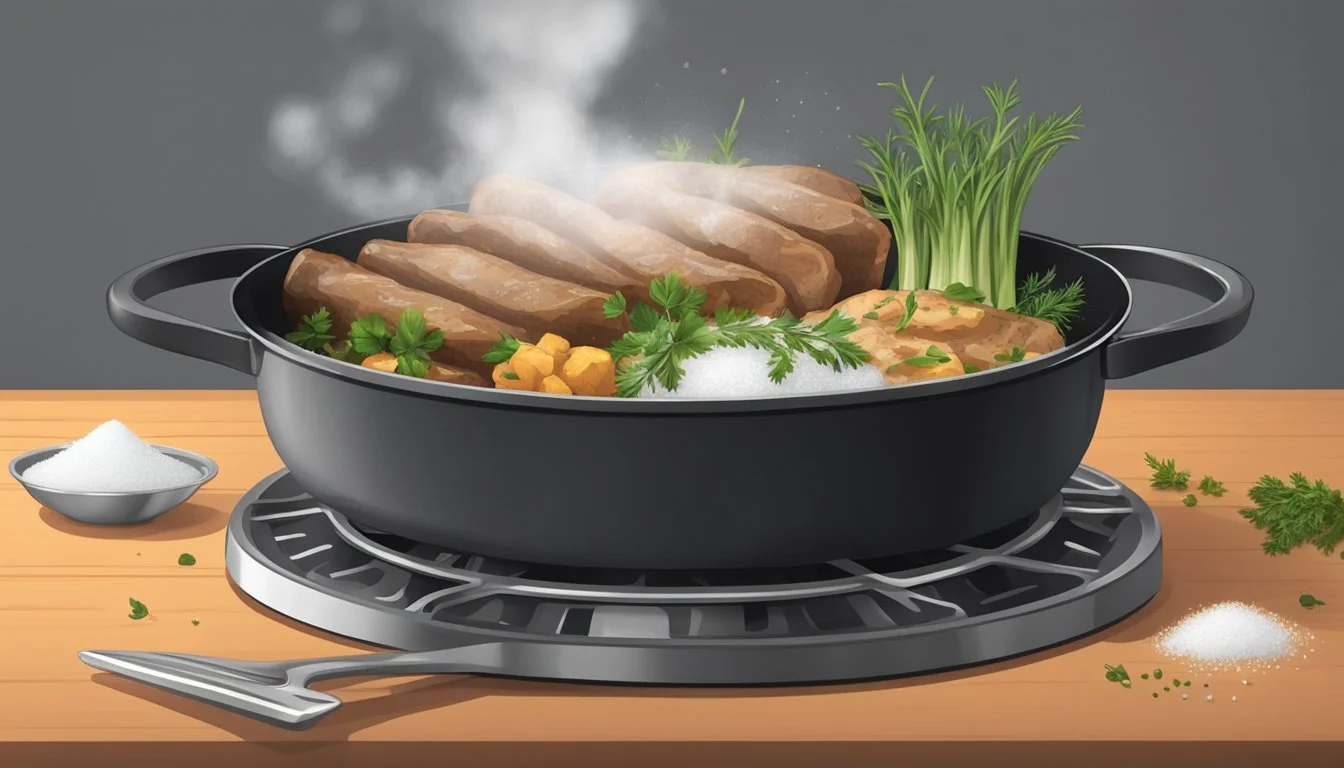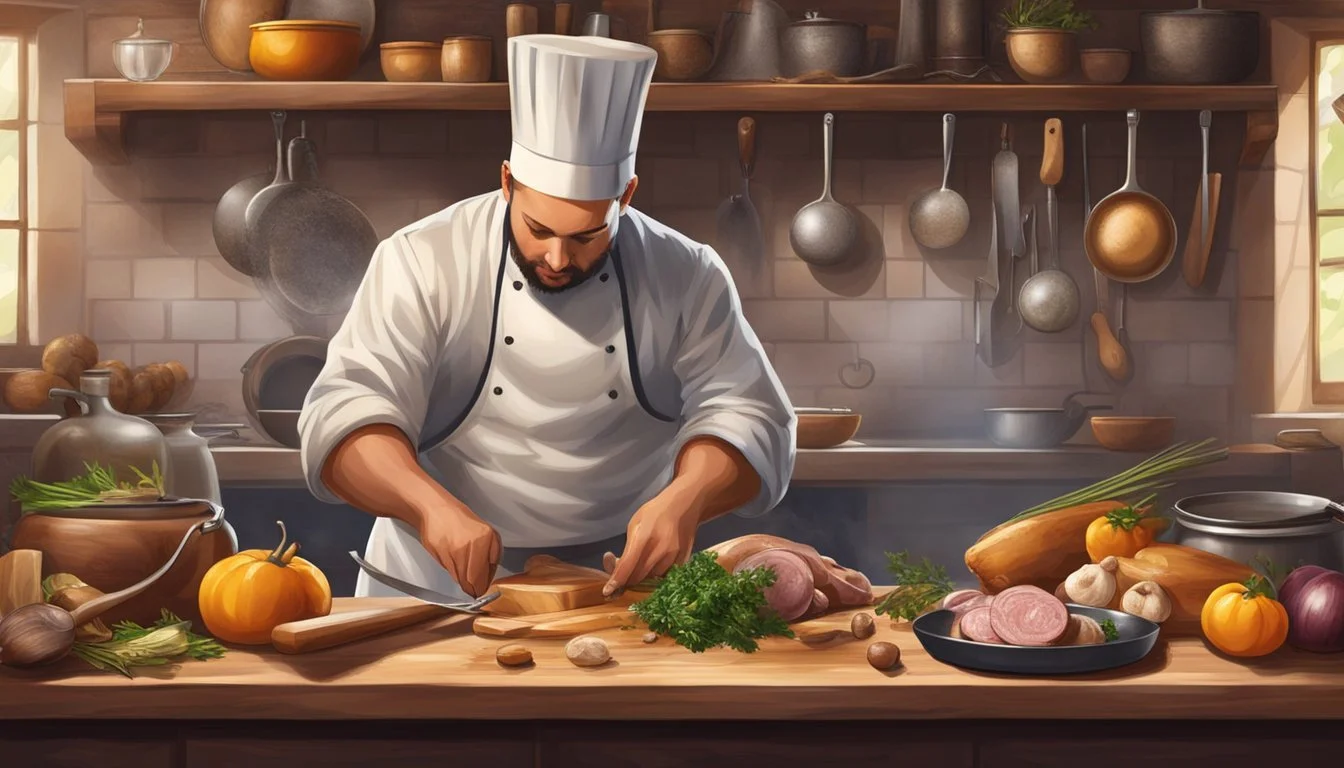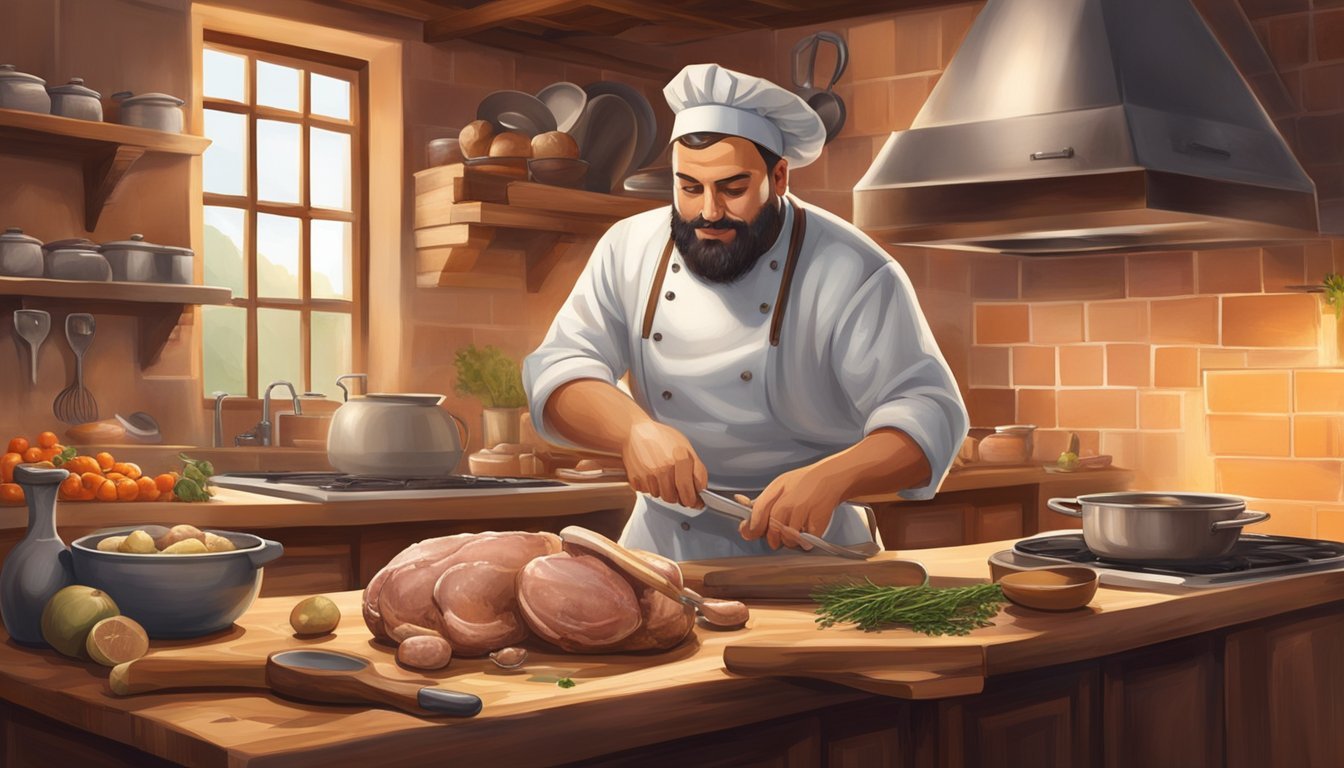Criadillas
A Savory Delicacy in Spanish Culinary Tradition
Criadillas, known commonly as bull testicles, have carved a distinctive niche in the rich tapestry of Spanish cuisine. This delicacy, rooted in tradition, is a fantastical testament to the adventurous spirit embedded within Spanish gastronomic culture. Though not as prevalent in contemporary menus, criadillas continue to be celebrated in certain regions of Spain for their unique flavor and texture. The dish is typically prepared by sautéing or frying the testicles after they have been thoroughly cleaned and boiled, offering a culinary experience that transcends conventional meat dishes.
Beyond Spain's borders, the preparation and enjoyment of criadillas also find a place in Mexican culinary practices. In Mexico, Criollas a la Mexicana—a dish featuring chopped bull testicles sautéed with traditional Salsa Mexicana—is a testament to the country's own take on this offbeat ingredient. Whether encountered in Spain or Mexico, bull testicles are a bold choice for those seeking to explore the less trodden paths of culinary exploration.
It is this courage to embrace all parts of an animal that speaks to the sustainable practices historically found in both Spanish and Mexican kitchens. Serving criadillas is more than a culinary dare; it's a nod to a time when nose-to-tail eating was not a trend but a way of life, an affirmation of respect for the animal by utilizing every edible part. As such, criadillas are a celebration of cultural heritage and a link to a shared, historical gastronomic philosophy that challenges modern day diners to redefine their culinary boundaries.
Historical Significance
Criadillas, or bull testicles, have a longstanding tie to bullfighting culture, signifying bravery and strength. They are a traditional dish in Spain and Mexico, with each region embracing unique preparation methods.
Cultural Symbolism
In Spain, criadillas are more than just a culinary item; they are steeped in the cultural backdrop of bullfighting. Bullfighting is an ancient spectacle that is regarded as an art form and is deeply integrated into Spanish history. Consuming bull testicles is symbolically linked to this tradition and is thought to embody the characteristics of the bull itself—bravery and strength. This organ meat is not only a means of sustenance but also a cultural statement, reflecting a connection to a time-honored and controversial practice.
Geographical Popularity
While Spain is the origin of bullfighting, the consumption of criadillas has also found its way to Mexico, where the influence of Spanish culture is pronounced. Here, criadillas are enjoyed as part of traditional dishes, like Criadillas a la Mexicana. Their preparation varies regionally from being served in stews, grilled, or fried.
Country: Spain
Common Dish: Criadillas
Preparation Method: Often sliced and pan-fried with garlic, oregano, and parsley
Country: Mexico
Common Dish: Criadillas a la Mexicana
Preparation Method: Cooked, chopped and sautéed with Salsa Mexicana
Both countries cherish this ingredient, adapting it to local tastes and continuing its legacy within their respective culinary frameworks.
Culinary Basics
In the world of Spanish cuisine, criadillas, or bull testicles, are a traditional dish that demand a careful approach to selection and preparation. The culinary journey of criadillas from the butcher's table to the dining plate involves precise ingredient choices and cooking techniques.
Selecting Quality Criadillas
It is essential to source fresh, high-quality criadillas from a reputable butcher. When selecting bull testicles, they should have:
A firm texture
An even color devoid of spots
A clean scent without any off-putting odors
Quality criadillas make the foundation of a successful dish, significantly influencing the final taste and texture.
Essential Ingredients
To properly honor the unique flavor of criadillas in Spanish recipes, the following ingredients should be incorporated:
Salt and pepper: These fundamental seasonings enhance the natural taste of the meat.
Olive oil: Preferably extra virgin, it serves as the ideal medium for sautéing or frying, adding a subtle aroma.
Garlic: Crushed or finely chopped, it contributes a pungent depth to the dish, complementing the meat's richness.
To cook criadillas, one starts by ensuring that they are cleaned and prepared correctly, then they're seasoned with salt and pepper and cooked with olive oil and garlic to create a traditional Spanish culinary experience.
Preparation Techniques
In the journey from farm to fork, bull testicles, or criadillas, require precise preparation. This section covers the initial cleaning and preparation process as well as a variety of cooking methods used in Spanish cuisine to transform criadillas into palatable dishes.
Cleaning and Preparing
Cleaning criadillas involves a few meticulous steps to ensure they are ready for cooking. A sharp knife is typically employed to filet the criadillas, carefully removing the outer membrane. It's essential to do this gently to keep the flesh intact. After the skin is discarded, the testicles should be sliced into the desired size, ranging from quarters to smaller pieces depending on the recipe.
Following the trimming, they are often washed and then soaked in salted water. This preliminary soak is important to draw out any impurities and to mildly season them. After soaking, they should be thoroughly rinsed and patted dry with paper towels.
Cooking Methods
Cooking criadillas can be approached in several ways; each method infuses the dish with a distinct flavor and texture. Common methods include:
Sautéing: Criadillas are frequently chopped and sautéed in a bit of fat, such as olive oil or lard, combined with flavors like chopped garlic and onion. They are cooked over medium-high heat until browned, usually for approximately 10 to 15 minutes.
Simmering: For a softer texture, they may be simmered in a pot of salted, boiling water covered for about 10 minutes. This method is often employed before frying or sautéeing.
Cooking Method: Sauté
Description: Quick cooking in fat, yielding a browned exterior.
Key Ingredients: Olive oil or lard, garlic, onions.
Cooking Time: 10-15 minutes
Cooking Method: Simmer
Description: Gentle cooking in liquid, for a tender interior.
Key Ingredients: Salted water.
Cooking Time: Approx. 10 minutes
Regardless of the chosen method, it's important to cook the criadillas thoroughly to ensure both safety and enjoyment of the dish. Each recipe may further season and enhance the testicles to suit the traditional palate of Spanish cuisine.
Traditional Recipes
In Spanish cuisine, criadillas, or bull testicles, offer a unique culinary experience with recipes that have been handed down through generations. These dishes present the ingredient in an authentic and delicious manner, often paired with robust flavors that capture the essence of Spain.
Spanish Criadillas
For a traditional Spanish approach, criadillas are prepared by first removing any exterior membrane, followed by cutting them lengthways into quarters. They are then simmered in a mixture of seasoned water. Common seasonings include onion, white wine vinegar, thyme, and perhaps a hint of cayenne pepper for a bit of heat. After being boiled, the criadillas are coated in a mix of egg and breadcrumbs and fried in vegetable oil until golden and crisp. The balance of textures and flavors embodies the rustic and hearty qualities Spanish cuisine is known for.
Tacos de Criadillas a la Mexicana
Moving to the Mexican-style recipe, criadillas are taken to a new level of flavor. After boiling, the testicles are chopped and sautéed in manteca (lard) to infuse them with richness. They are then combined with salsa mexicana, consisting of diced tomatoes, onions, cilantro, and fresh chili peppers, providing a vibrant contrast to the richness of the criadillas. The mixture is served in warm corn tortillas and garnished with fresh herbs. This approach to criadillas showcases the ability of Mexican cuisine to integrate unusual ingredients into delicious and approachable dishes.
Serving and Presentation
When serving criadillas in Spanish cuisine, they are often presented as tapas (What wine goes well with tapas?), small plates intended for sharing. The key to a successful presentation lies in the thoughtful selection of accompaniments and garnishes that enhance both the flavor and visual appeal of the dish.
Accompaniments and Garnishes
Criadillas are traditionally served with a variety of garnishes that complement their unique flavor. A few specific accompaniments include:
Cilantro: Freshly chopped cilantro provides a bright, herbal note that balances the rich taste of the criadillas.
Roma Tomatoes: Diced Roma tomatoes add a juicy, tangy element to counter the dish's savoriness.
Salsa: A homemade salsa, often including onions and chili peppers, lends a spicy kick and additional depth of flavor.
Here's a simple presentation suggestion for serving criadillas as tapas:
Slice the criadillas into bite-sized pieces after cooking.
Arrange the pieces neatly on a small plate.
Sprinkle with cilantro and diced Roma tomatoes.
Serve with a side of salsa for guests to add as per their taste preference.
This combination ensures that the dish is not only delicious but also visually enticing, and the fresh garnishes provide a contrast that's crucial for balancing the flavors and bringing the taste of Spanish cuisine to life.
Modern Interpretations and Variations
In Spanish cuisine, criadillas have long been regarded as a delicacy, with customary recipes passed down through generations. Yet in recent years, chefs have been embracing these beef testicles with innovative twists, expanding their savory potential.
Adaptations in Contemporary Cuisine
In contemporary cuisine, criadillas are being reimagined to cater to modern palates, often integrating them into familiar dishes. The nature of this offal lends itself to various cooking methods beyond traditional pan-frying. Chefs are experimenting with:
Criadillas Tacos: Incorporating finely diced bull testicles into taco fillings, seasoned with bold spices and topped with fresh salsa and avocado.
Criadillas Ceviche: A dish that often features seafood, now seeing a unique variation with thinly sliced criadillas cured in citrus juices and combined with crisp vegetables.
Criadillas in Fusion Cooking: Fusing traditional Spanish flavors with international cuisines, such as criadillas served with Asian-inspired dipping sauces or incorporated into Italian-style carpaccio.
These innovations not only honor the delicious nature of traditional Spanish cuisine but also introduce criadillas to those seeking novel culinary adventures. Chefs are demonstrating that this ingredient can be both versatile and approachable, bringing a touch of daring to fine dining and casual eateries alike.
Nutritional and Health Considerations
Bull testicles, or criadillas as they are known in Spanish cuisine, are a unique delicacy that also offer certain nutritional benefits.
Understanding the Health Benefits
Bull testicles are rich in proteins, which are essential for muscle repair and growth. They contain a full profile of amino acids, the building blocks of proteins, making them a beneficial addition to a protein-focused diet. Here's how they stand nutritionally:
Protein Content: Bull testicles are a source of high-quality protein. This means they can be a valuable food for individuals looking to increase their protein intake, whether for muscle building or general health.
When considering the addition of bull testicles to one's diet from a health perspective, it is important to weigh their protein content against other macronutrients and to integrate them as part of a balanced diet.
Ethical and Environmental Discussion
In the context of Spanish cuisine, the use of criadillas, or bull testicles, brings forth discussions on ethical livestock farming practices and the environmental impacts of bullfighting traditions. This section will explore the nuanced discourse surrounding these aspects.
Considerations in Livestock Farming
The manner in which livestock is raised for culinary purposes, including criadillas, factors into ethical considerations. Animal welfare standards are pivotal, as they dictate the quality of life for the animals before they become part of the food supply. Sustainable farming practices not only ensure better conditions for the animals but also help in preserving the nature of local ecosystems. Criadillas are a by-product of castration practices which aim at controlling aggression and managing breeding within herds.
Animal Welfare Standards: involve providing adequate space, nutrition, and medical care for animals.
Sustainable Practices: strategies that minimize waste, conserve water, and reduce greenhouse gas emissions.
Impact of Bullfighting on Cuisine
Bullfighting, a controversial spectacle deeply ingrained in Spanish history, influences local cuisine, especially the consumption of criadillas. Traditionally, these events contribute to meat supply, as the bulls are slaughtered and parts like the testicles are utilized for dishes such as Criadillas a la Mexicana.
Cultural Significance: Bullfighting is considered an art form by proponents, with historical ties to Spanish identity.
Environmental Concerns: On the opposing side, critics point out the associated animal cruelty and question the sustainability of bullfighting in modern society.
The ethics of consuming criadillas cannot be separated from the context in which they are sourced, whether it be standard livestock farming or as part of bullfighting traditions. Each practice carries its own environmental footprint and ethical dilemmas that consumers must consider.
Conclusion
Criadillas, commonly known among English speakers as bull testicles, hold a distinct place in Spanish cuisine. They are often seen as a delicacy, valued for their unique texture and flavor. Preparing criadillas involves a series of steps beginning with thorough cleaning and boiling before they are finally cooked with various seasonings.
Traditional recipes often call for the criadillas to be pan-fried or grilled, sometimes incorporating them into stews. When seasoned and cooked properly, they can be quite palatable, akin to other offal enjoyed around the world. A common method is to chop them into bite-sized pieces after cooking and sauté them with traditional spices or Salsa Mexicana.
In terms of their nature and flavor, descriptions vary. Some compare the taste to certain seafood, while others simply appreciate it as a unique culinary experience. The key to a delicious outcome lies in proper preparation and an openness to explore this unconventional ingredient.
In summary, criadillas offer adventurous food lovers an opportunity to expand their palate. While not for everyone, these dishes embody a part of Spanish culinary heritage. Those willing to try them may be pleasantly surprised by their depth of flavor and the culinary tradition they represent.







